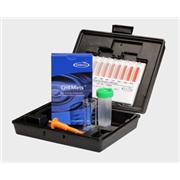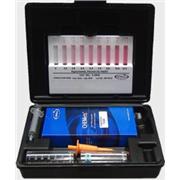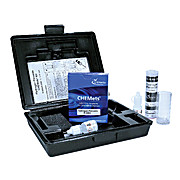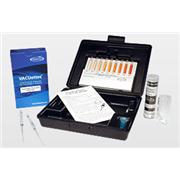CHEMetrics Portable Water Quality Test Kits
-
Kit comes in a plastic case and contains everything needed to perform 30 tests (except distilled water): Refill, Low and High Range Comparators, dilutor snapper cup, micro test tube, and instructions. Range: 0-1000 & 1000-10,000 ppm MDL: 100 ppm Method: Direct Nesslerization …
-
Glycol CHEMets Kit
CHEMetricsEthylene glycol and propylene glycol are the primary ingredients in commercially-available antifreezes. They are used with various corrosion inhibitors to protect metal surfaces in cooling water systems. CHEMetrics glycol kits are used to monitor potable waters for glycol contamination…
-
Formaldehyde CHEMets Kit
CHEMetricsFormaldehyde, a toxic substance, is used in the following applications: metal plating baths, textile treatments, biological specimen preservatives, and disinfectants of medical equipment. Commercial formaldehyde gas is readily soluble in water. The Purpald Method Reference:…
-
Hydrazine VACUettes Kit, Range: 0-25 ppm
CHEMetricsHydrazine is a powerful reducing agent that is used in various chemical processes and in boiler water as an oxygen scavenger. To control corrosion, residual hydrazine typically is maintained in the 0.05 to 0.1 mg/L range. Higher levels may be used to guard against corrosion when the boiler is out…
-
Kit comes in a plastic case and contains everything needed to perform 30 tests (except distilled water): Refill, Low and High Range Comparators, dilutor snapper cup, micro test tube, and instructions. Range: 0-60 & 60-600 ppm MDL: 10 ppm Method: Direct Nesslerization …
-
Iron (Total & Ferrous) Vacu-vials Kit
CHEMetricsIron is present in nature in the form of its oxides, or in combination with silicon or sulfur. The soluble iron content of surface waters rarely exceeds 1 mg/L, while ground waters often contain higher concentrations. The National Secondary Drinking Water Standard for iron is 0.3 mg/L, as iron…
-
Ammonia Vacu-vials Kit, Range: 0-14.0 ppm
CHEMetricsLow-level ammonia nitrogen may be naturally present in water as a result of the biological decay of plant and animal matter. Higher concentrations in surface waters can indicate contamination from waste treatment facilities, raw sewage, industrial effluents (particularly from petroleum refineries),…
-
Molybdate CHEMets Kit, Range: 20-200 ppm
CHEMetricsMolybdate is used throughout the industrial water treatment and power generation industries as a corrosion inhibitor in both open- and closed-loop cooling water systems. In solution, molybdate anions complex with oxidized iron to form a protective film of molybdate and ferric-oxide. Molybdate is…
-
Ozone Vacu-vials Kit
CHEMetricsOzone is a strong oxidizing agent and is used as an alternative to chlorine as a biocide in the disinfection of drinking water. Ozone is used to remove odor, decolorize, and to control algae and other aquatic growths. Ozone is also used in various disinfectant and sterilization processes in…
-
Chloride Titrets® Test Kits
CHEMetricsChloride is the most common inorganic anion found in water and wastewater. The Maximum Secondary Contaminant Level for drinking water for chloride is 250 mg/L. Natural sources of salt are the ocean and various salt deposits above and below ground. Chloride is very corrosive to most metals in…
-
Copper (Soluble) Vacu-vials Kit
CHEMetricsCopper is naturally present in the earth’s crust and in seawater. Copper-containing fungicides are used to control biological growth in water supplies. The Maximum Contaminant Level Goal for copper is 1.3 mg/L in drinking water. The measurement of copper is an important means of monitoring…
-
Nitrate CHEMets Kit, Range: 0-2700 ppm
CHEMetricsNitrate is the most completely oxidized form of nitrogen. It is formed during the final stages of biological decomposition, either in wastewater treatment facilities or in natural water supplies. Low-level nitrate concentrations may be present in natural waters. However, a Maximum Contaminant Level…
-
Because of its strong oxidizing properties, chlorine is an excellent biocide used to treat potable waters, municipal wastes, and swimming pools. When used to treat potable water, chlorine helps alleviate the adverse effects of iron, manganese, ammonia, and sulfide. The Maximum Residual Disinfectant…
-
Iron is present in nature in the form of its oxides, or in combination with silicon or sulfur. The soluble iron content of surface waters rarely exceeds 1 mg/L, while ground waters often contain higher concentrations. The National Secondary Drinking Water Standard for iron is 0.3 mg/L, as iron…
-
Nitrate Vacu-vials Kit, Range: 0-1.50 ppm
CHEMetricsNitrate is the most completely oxidized form of nitrogen. It is formed during the final stages of biological decomposition, either in wastewater treatment facilities or in natural water supplies. Low-level nitrate concentrations may be present in natural waters. However, a Maximum Contaminant Level…
-
Phenols VACUettes® Kits
CHEMetricsPhenol (hydroxybenzene) is the simplest of a group of similar organic chemicals, which includes cresols, xylenols, and catechols. Phenol itself is a common ingredient of disinfectants. In drinking water, low-level phenolic concentrations impart a foul taste and odor, especially upon chlorination.…
-
Iron in Brine CHEMets Kit
CHEMetricsIron is present in nature in the form of its oxides, or in combination with silicon or sulfur. The soluble iron content of surface waters rarely exceeds 1 mg/L, while ground waters often contain higher concentrations. The National Secondary Drinking Water Standard for iron is 0.3 mg/L, as iron…
-
Manganese CHEMets Kit
CHEMetricsSurface and ground waters rarely contain more than 1 mg/L of soluble or suspended manganese. Manganese can act as an oxidizing or a reducing agent depending on its valence state. Manganese is also used in the manufacture of batteries and as an alloying metal in the manufacture of steel and…
-
Chlorine Comparator
CHEMetricsThe CHEMetrics chlorine comparator is ideal for drinking water applications, by detecting the percentage of chlorine present in water. It is easy to use and ensures accurate testing.
-
Chloride Vacu-vials® Kits
CHEMetricsChloride is the most common inorganic anion found in water and wastewater. The Maximum Secondary Contaminant Level for drinking water for chloride is 250 mg/L. Natural sources of salt are the ocean and various salt deposits above and below ground. Chloride is very corrosive to most metals in…
-
Hydrazine VACUettes Kit, Range: 0-12.5 ppm
CHEMetricsHydrazine is a powerful reducing agent that is used in various chemical processes and in boiler water as an oxygen scavenger. To control corrosion, residual hydrazine typically is maintained in the 0.05 to 0.1 mg/L range. Higher levels may be used to guard against corrosion when the boiler is out…
-
Hydrogen peroxide is a strong oxidizing agent with a variety of uses. Applications include the treating of industrial effluents and domestic waste and serving as a disinfectant in aseptic packaging. For the food and beverage industry, CHEMetrics Hydrogen Peroxide CHEMets® and…
-
Manganese Vacu-vials Kit
CHEMetricsSurface and ground waters rarely contain more than 1 mg/L of soluble or suspended manganese. Manganese can act as an oxidizing or a reducing agent depending on its valence state. Manganese is also used in the manufacture of batteries and as an alloying metal in the manufacture of steel and…
-
Hydrazine VACUettes Kit, Range: 0-50 ppm
CHEMetricsHydrazine is a powerful reducing agent that is used in various chemical processes and in boiler water as an oxygen scavenger. To control corrosion, residual hydrazine typically is maintained in the 0.05 to 0.1 mg/L range. Higher levels may be used to guard against corrosion when the boiler is out…
-
Silica Vacu-vials® Kits
CHEMetricsSilica (SiO2) is the oxide of silicon, the second most abundant element in the earth's crust. Silica is present as silicates in most natural waters. Typical concentrations lie between 1 and 30 mg/L. Higher concentrations may exist in brackish waters and brines. The silica content of…
-
Copper (Soluble) CHEMets Kit
CHEMetricsCopper is naturally present in the earth’s crust and in seawater. Copper-containing fungicides are used to control biological growth in water supplies. The Maximum Contaminant Level Goal for copper is 1.3 mg/L in drinking water. The measurement of copper is an important means of…
-
Molybdate CHEMets Kit, Range: 0-7 ppm
CHEMetricsMolybdate is used throughout the industrial water treatment and power generation industries as a corrosion inhibitor in both open- and closed-loop cooling water systems. In solution, molybdate anions complex with oxidized iron to form a protective film of molybdate and ferric-oxide. Molybdate is…
-
Because of its strong oxidizing properties, chlorine is an excellent biocide used to treat potable waters, municipal wastes, and swimming pools. When used to treat potable water, chlorine helps alleviate the adverse effects of iron, manganese, ammonia, and sulfide. The Maximum Residual Disinfectant…
-
Hydrogen peroxide is a strong oxidizing agent with a variety of uses. Applications include the treating of industrial effluents and domestic waste and serving as a disinfectant in aseptic packaging. The Ferric Thiocyanate Method Reference: D. F. Boltz and J. A. Howell, eds.,…
-
Sulfide CHEMets® Kits
CHEMetricsSulfides are naturally present in ground waters as a result of leaching from sulfur-containing mineral deposits. Surface waters do not usually contain high sulfide concentrations. Sulfides result from the decomposition of organic matter, from bacterial sulfate reduction under anaerobic conditions…
-
Sulfide Vacu-vials® Kits
CHEMetricsSulfides are naturally present in ground waters as a result of leaching from sulfur-containing mineral deposits. Surface waters do not usually contain high sulfide concentrations. Sulfides result from the decomposition of organic matter, from bacterial sulfate reduction under anaerobic conditions…
-
Iron CHEMets Kit
CHEMetricsIron is present in nature in the form of its oxides, or in combination with silicon or sulfur. The soluble iron content of surface waters rarely exceeds 1 mg/L, while ground waters often contain higher concentrations. The National Secondary Drinking Water Standard for iron is 0.3 mg/L, as iron…



































